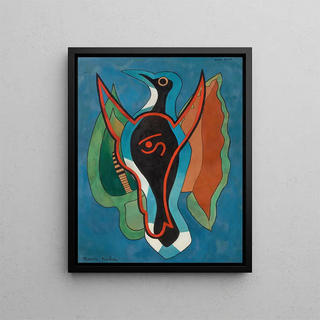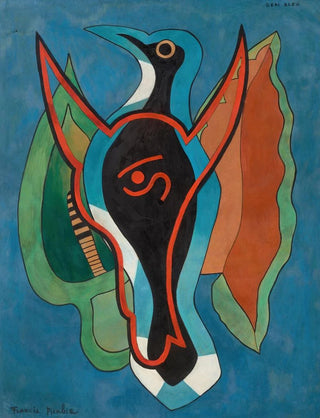Art print | Blue Jay - Francis Picabia Source: Reproduction | Geai bleu - Francis Picabia


View from behind

Frame (optional)
The "Blue Jay" by Francis Picabia is a work that captivates with its ability to capture the very essence of modernity. Created in the early 20th century, this painting embodies a dialogue between nature and abstraction, a theme dear to the artist. The choice of the blue jay, an emblematic and colorful bird, evokes both wild beauty and the delicacy of forms. Through this art print, Picabia invites us to a sensory exploration, where vibrant colors and bold lines blend to create a unique atmosphere. The art print of the Blue Jay - Francis Picabia allows for appreciation of this masterpiece while offering a glimpse into the artistic universe of its creator.
Style and uniqueness of the work
The "Blue Jay" stands out for its daring style, oscillating between cubism and surrealism. The composition is marked by geometric shapes and bright colors, which seem to dance across the canvas. Picabia plays with light and shadow, creating a depth effect that draws the eye and encourages exploration. The brushstrokes, both precise and free, reveal undeniable technical mastery while allowing a certain spontaneity to shine through. This work does not merely depict a bird; it evokes a world where nature and art meet, where each brushstroke is an invitation to feel the raw emotion of the moment. The chromatic richness and the dynamism of the composition make this painting an essential piece for any art enthusiast.
The artist and his influence
Francis Picabia, an emblematic figure of the avant-garde movement, transcended the artistic conventions of his time. Born in 1879 in Paris, he explored various styles throughout his career, from Fauvism to Dadaism. His innovative approach influenced many contemporary artists and helped redefine the boundaries of modern art. Picabia was a visionary, capable of capturing the spirit of his era while breaking free from established norms. His work "Blue Jay" testifies to this relentless quest for freedom and experimentation.

Matte finish

View from behind

Frame (optional)
The "Blue Jay" by Francis Picabia is a work that captivates with its ability to capture the very essence of modernity. Created in the early 20th century, this painting embodies a dialogue between nature and abstraction, a theme dear to the artist. The choice of the blue jay, an emblematic and colorful bird, evokes both wild beauty and the delicacy of forms. Through this art print, Picabia invites us to a sensory exploration, where vibrant colors and bold lines blend to create a unique atmosphere. The art print of the Blue Jay - Francis Picabia allows for appreciation of this masterpiece while offering a glimpse into the artistic universe of its creator.
Style and uniqueness of the work
The "Blue Jay" stands out for its daring style, oscillating between cubism and surrealism. The composition is marked by geometric shapes and bright colors, which seem to dance across the canvas. Picabia plays with light and shadow, creating a depth effect that draws the eye and encourages exploration. The brushstrokes, both precise and free, reveal undeniable technical mastery while allowing a certain spontaneity to shine through. This work does not merely depict a bird; it evokes a world where nature and art meet, where each brushstroke is an invitation to feel the raw emotion of the moment. The chromatic richness and the dynamism of the composition make this painting an essential piece for any art enthusiast.
The artist and his influence
Francis Picabia, an emblematic figure of the avant-garde movement, transcended the artistic conventions of his time. Born in 1879 in Paris, he explored various styles throughout his career, from Fauvism to Dadaism. His innovative approach influenced many contemporary artists and helped redefine the boundaries of modern art. Picabia was a visionary, capable of capturing the spirit of his era while breaking free from established norms. His work "Blue Jay" testifies to this relentless quest for freedom and experimentation.






